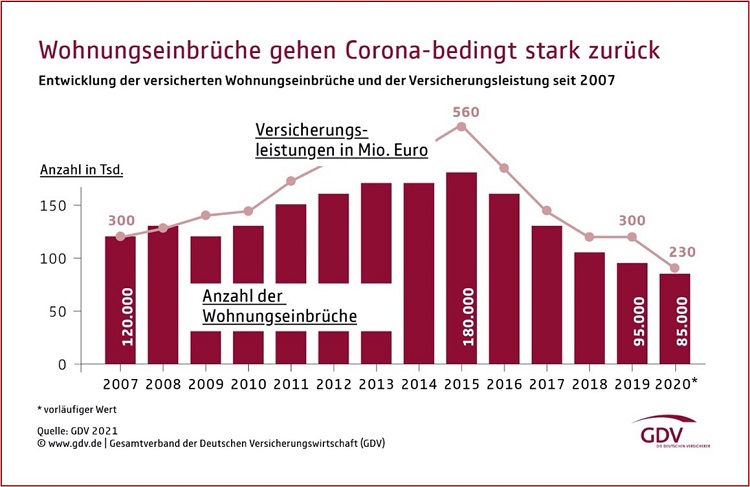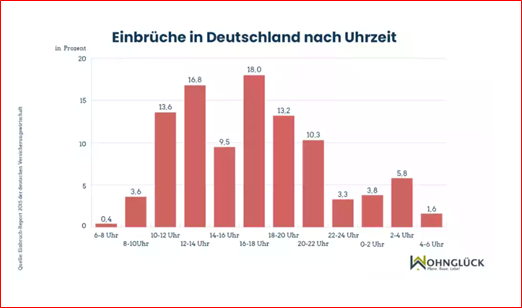 Source: iStock.com/rclassenlayouts
Source: iStock.com/rclassenlayouts
Winter is peak season for burglaries: Stay safe this winter with the Smart Security solutions from Gigaset
17. December 2021 Published by Raphael DoerrThere are a few things burglars definitely don’t like: occupants at home, vigilant neighbors, barking dogs, break-ins that take up too much time, and loud noises. What does that tell us? Burglars plan ahead, don’t take unnecessary risks, have strict working hours and appreciate peace and quiet. This blog post will examine these points in greater detail and identify any conclusions that can be drawn from them about Smart Security for the smart home.
They come when nobody’s home
In this respect, Covid-19 was a nightmare for the housebreaking community. Owing to the many lockdowns alone, the German broadcaster SWR cheered at the following headline at the end of 2020: “Domestic burglaries expected to be at lowest level for 50 years due to Covid.” According to the figures announced by the German Minister of the Interior on April 15, 2021, the number of domestic burglaries fell by just under 14%. Almost 47% of the burglaries were aborted before entry was gained. Conversely, the number of cases of theft from basement rooms, lofts and washrooms increased. Police statistics for this type of theft add up to a total of 96,188 reported cases, an 11% rise compared to the previous year. Experts have identified the coronavirus pandemic as the main cause of the drop in domestic burglaries. Because more people stayed at home in 2020 due to home office, home schooling, lockdowns, etc., domestic premises were practically permanently occupied, leading to a fall in break-ins. Numerous studies have shown that the majority of burglars avoid breaking into properties when the occupants are at home.

No reason for complacency
Even though the absolute number of domestic burglaries in Germany fell again in 2020, the thieves gained unauthorized access to premises in a total of 85,000 cases. According to figures published by the German Insurance Association (GDV), however, this number is 10,000 down on the previous year, and at the lowest level since statistics began in 1998.
Vigilant neighbors
Having “vigilant neighbors” is an absolute trump card in the fight against organized gangs of burglars. And it’s a card that should definitely be played by anyone who has friendly neighbors willing to take on the task. What does it involve? In an experiment described by Focus Online, criminologists at the Max Planck Institute for the Study of Crime, Security and Law in Freiburg, Germany, collaborated with British and Dutch scientists to set up a research project in which 353 men were sent through a virtual neighborhood in search of a burglary target. The participants were all wearing virtual reality headsets, with houses, lawns and bushes all depicted in extremely realistic detail. Participants were also provided with headphones, delivering everyday noises that deepened the impression of actually being in the neighborhood. But this was no computer game. The participants in the study were tasked with scouting the virtual neighborhood for opportunities to commit a burglary, and with identifying any perceived risks to their intentions. What made this experiment so unusual was the fact that the 353 participants who took part in this study included 181 convicted burglars, who were visited by the researchers in prison. The remaining participants were students. The scientists made life more difficult for the potential burglars by failing to depict any surveillance cameras or alarm systems installed in the virtual neighborhood. Earlier studies had shown that alarm systems do not always act as a deterrent to burglars. However, a sticker with the words “Beware of vigilant neighbors” is much more effective. And it can be obtained free of charge from police authorities.
The experiment proved that the mere presence of neighbors acted as a deterrent for both groups of participants. In all cases where a neighbor was present, whether they were looking in the direction of the potential burglar or simply standing around in the garden, the participants abandoned any plans they had.
What can we learn from this?
So what conclusions can we draw and what precautionary measures could we take?
- You could invite the 80-year-old lady from next door to a cup of tea or coffee and ask her if she would be prepared to make an appearance in the garden/stairwell three times during the day and twice in the evening, while you’re at work, shopping or at the cinema. And you might also offer her a small financial incentive to shout “Is anyone there?”
- You could order the sticker saying “Beware of vigilant neighbors” and attach it in a clearly visible location to the outside of your house or apartment. (This will only be effective, of course, in combination with case a), and when the burglar is not a seasoned professional.)
- You could buy a watchdog. “Cave canem” (Beware of the dog) was already an effective deterrent in ancient Rome. Man’s best friend is one of the burglars’ worst enemies: Many would-be burglars take flight when they hear a growling or barking dog.
- You could buy a smart home system to replace neighbors and dogs with Alexa, Siri and the like.
- You could buy an electronic watchdog on Amazon, one that doesn’t need to be taken for a walk, can bark at a volume of up to 120 dB, and boasts realistic 3D sound effects.
Can the neighbor replace the modern security technology provided by smart home systems?
But on a more serious note, burglars aren’t stupid. The precautions above could bear fruit, but there’s no guarantee. The results of the crime survey in the German state of North Rhine-Westphalia (Kriminalitätsmonitor NRW) tell us that anyone who believes they can do without security technology because they live in a densely populated area, where neighbors would notice any attempts at burglary, is making a serious mistake. In point of fact, exactly the opposite is true. The frequency of domestic break-ins increases in line with a community’s population figures. Anonymity is a factor that criminals use to their advantage. Particularly in apartment blocks with a very high number of occupants, it’s practically impossible to know all the neighbors. This helps burglars avoid detection when penetrating a building and makes it easier for them to escape with their spoils again afterwards. Potential housebreakers reckon that people they come across in halls and stairwells will assume they are other occupants of the building, taking little notice of them and remaining unable to describe them in any detail.
According to Germany’s Federal Criminal Police Office (BKA), there are considerably more burglaries in winter than in summer. Large cities, urban areas and communities alongside major highways tend to be the hotspots. And it’s rare for the criminals to be apprehended. In 2019, only 17 in 100 domestic burglaries were successfully investigated.
Tips from the experts
To achieve an adequate level of security, the authors behind the crime survey in North-Rhine Westphalia advise occupants (particularly those living on the ground floor) to fit lockable window handles, purchase sturdy locks and fittings for doors, and install an alarm system. 3.7% of respondents living on the ground floor of apartment buildings stated that they had been victims of a burglary within the preceding 18 months. In just under half of these cases, the intruders entered through the front door of the apartment. 31% came through French windows, and 21% through other windows. The reason why front doors of apartments are more at risk than those of detached homes is because they are normally less well secured and often left unlocked during the night.
Under cover of darkness
The vast majority of burglars want to avoid being seen or recognized, and this has implications for their preferred hours of work and their favorite seasons. According to the “Wohnglück” website, between 4 p.m. and 8 p.m. is the peak period for break-ins. Around 36% of burglaries occur in this time period after work when people go shopping, visit friends or take in a movie. Unsurprisingly, in the morning between 6 a.m. and 8 a.m. we are relatively unlikely to have such uninvited guests in our homes. The Burglary Report published by the German Insurance Association (GDV) indicates that only one in seven burglaries (14.5%) takes place between 10 p.m. in the evening and 6 a.m. in the morning. But over half of break-ins (57.9%) are recorded between 10 a.m. and 6 p.m. The inevitable exceptions excluded, burglars seem to stick to time-honored traditions. And that’s why most people commonly link break-ins with the darker months of the year.

There’s absolutely no doubt that security technology is a worthwhile investment in the dark of winter. Experts estimate that every second burglary attempt fails because the potential thieves are unable to enter the premises quickly enough. Can we therefore assume that burglars are particularly impatient people or are prone to giving up too easily? Neither assumption would be true. The real reason is that the risk of discovery grows with every minute they fail to gain entry. In an interview with the Allianz Magazin website, ex-burglar Hammed Khamis confirmed this: “Of course, massive doors and windows plus additional features such as a horizontal security bar on the door make life more difficult for thieves. The longer they take to get in, the sooner they give up. An alarm system that is hidden from view is a good idea. When an alarm system can be clearly seen from a distance, however, perhaps in combination with a surveillance camera, the thief might conclude that such a well-protected house is probably worth robbing. So it could act as more of an invitation than a deterrent. The surveillance camera is not much of an obstacle anyway. All you need to do is swivel it to one side and unplug it. Job done!”
Planning is everything
Unfortunately, organized crime has become a fact of everyday life, and domestic burglaries are increasingly being carried out by internationally operating criminal gangs. These professional criminals minimize the risk by planning every little detail of their activities. When they are unfamiliar with a particular location, they send out scouts to explore the area and locate possible targets. A few days before a potential burglary, these scouts wander through streets, neighborhoods and sometimes whole districts without any danger of being identified. They are able to closely observe the people who are coming and going, and who is at home or absent at particular times of day. This information is frequently documented for possible targets, making things easier for accomplices later on.
Relevant information about the occupants (dog, lives alone, senior citizen, worthwhile target, etc.) is sometimes left directly on the house in the form of a secret “burglars’ code”. This cryptic code employs written symbols or special markings, and sometimes even strips of plastic, to indicate whether a house or is occupied or not. You may have even seen such symbols yourself without having any idea what they were. A small cross-shaped chalk mark is inconspicuous. And, even if it is discovered, it will probably be attributed to neighborhood kids rather than an organized criminal gang. Even a zigzag shape lightly scratched into the front door may escape notice, particularly when most people have no idea what such criminal codes look like.

Secret codes of this kind for non-verbal communication have been around since the Middle Ages. A research group at the University of Passau has studied the historical usage and meaning of such symbols and come to the conclusion that they “belong to a particular section of the population that lives constantly in fear of repressions due to the prevailing social conditions.” In Medieval and Early Modern societies, this included not only criminal bands but also all members of the low status classes. In those days, beggars, peddlers and casual laborers also used codes to communicate with other members of their social groups, mainly indicating where it was worthwhile to approach the occupants.
Things you should know
Thieves have developed a number of techniques for quickly entering properties without being noticed. Windows, gardens and front doors provide numerous opportunities to gain access to a building. Anyone who has been forced to call a locksmith after losing their key will have been amazed at how quickly the door was opened. A locksmith can show you how your door can be opened in less than 15 seconds with the “credit card hack” (but he’ll also charge you around 150 euros for the call-out). And professional criminals are just as skillful as locksmiths. If there’s no additional deadbolt securing the door, a credit card will be the only thing a burglar needs. And, as Cologne’s Chief of Police Uwe Jacob has personally demonstrated, a closed and unsecured window can be opened in just four seconds.
“When a professional burglar is determined to steal jewels or a valuable painting that he knows you have in your home, he will come up with a plan and find a way in – even if it means climbing down the chimney,” says former burglar Hammed Khamis in Allianz Magazin. But he admits that things are not the same with casual thieves. “They walk around carrying a screwdriver or crowbar and simply wait for the next best opportunity to quickly force a door or window open. I never spent more than 30 seconds attempting this sort of thing.” If you want to protect yourself against threats of this kind, modern security technology and appropriate smart security solutions are a must.
A solution that gives you (almost) everything
At the beginning of this blog post, we made a list of the things that burglars don’t like: a) occupants at home, b) vigilant neighbors and barking dogs, c) break-ins that take up too much time and d) loud noises.
You can implement all these deterrents with the Smart Security products from Gigaset. You will then have greatly enhanced security that doesn’t put too much strain on your bank balance and can be expanded at any time.
We’ll show you how in the next blog post.
 Comments
Comments
 en
en 







